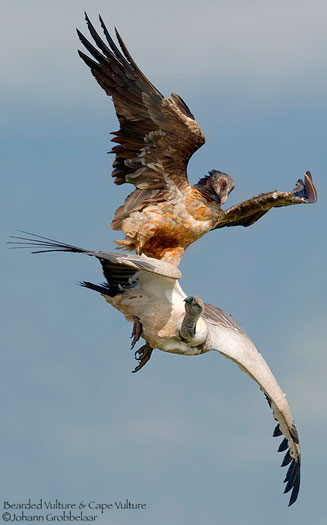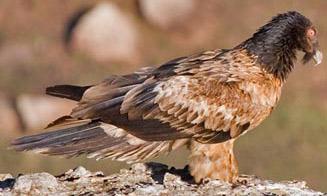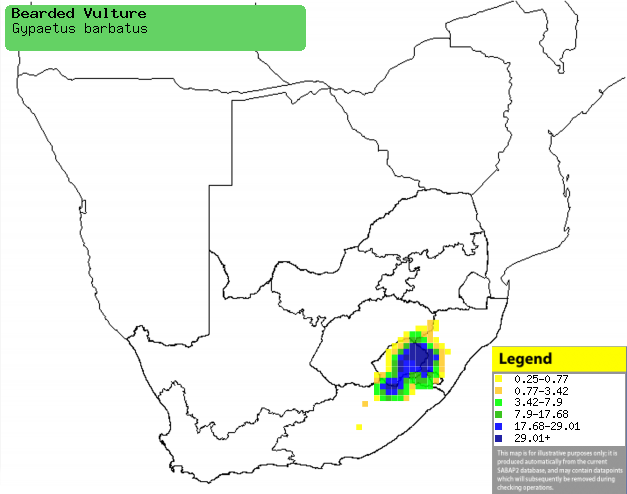|
Gypaetus barbatus (Bearded
vulture, Lammergeier)
Baardaasvoėl [Afrikaans]; uKhozilwentshebe [Zulu]; Ntsu
(also applied to Tawny eagle), Ntsu-kobokobo [South Sotho]; Lammergier,
Baardgier [Dutch]; Gypačte barbu [French]; Bartgeier [German];
Quebra-ossos [Portuguese]
Life
> Eukaryotes >
Opisthokonta
> Metazoa (animals) >
Bilateria >
Deuterostomia > Chordata >
Craniata > Vertebrata (vertebrates) > Gnathostomata (jawed
vertebrates) > Teleostomi (teleost fish) > Osteichthyes (bony fish) > Class:
Sarcopterygii (lobe-finned
fish) > Stegocephalia (terrestrial
vertebrates) > Tetrapoda
(four-legged vertebrates) > Reptiliomorpha > Amniota >
Reptilia (reptiles) >
Romeriida > Diapsida > Archosauromorpha > Archosauria >
Dinosauria
(dinosaurs) > Saurischia > Theropoda (bipedal predatory dinosaurs) >
Coelurosauria > Maniraptora > Aves
(birds) > Order: Falconiformes
> Family: Accipitridae
 |
 |
 |
|
Bearded vulture attacking a Cape vulture, Giant's
Castle, South Africa. [photo Johann Grobbelaar
©] |
Top right: Bearded vulture adult, Giant's Castle, South
Africa. [photo
Callie de Wet ©]
Bottom right: Bearded vulture juvenile, Giant's Castle, South
Africa. [photo
Neil Gray
©] |
Distribution and habitat
Occurs in Eurasia, North Africa and sub-Saharan Africa from
eastern Sudan to northern Tanzania. It has an isolated population in Lesotho
and adjacent KwaZulu-Natal, Eastern Cape and eastern Free State, generally
preferring alpine and mixed grassland on rugged mountains and escarpments.
|
 |
|
Distribution of Bearded vulture in southern Africa,
based on statistical smoothing of the records from first SA Bird Atlas
Project (©
Animal Demography unit, University of
Cape Town; smoothing by Birgit Erni and Francesca Little). Colours range
from dark blue (most common) through to yellow (least common).
See here for the latest distribution
from the SABAP2. |
Predators and parasites
The chicks have been recorded as prey of
Corvus
albicollis (White-necked raven).
Movements and migrations
Resident and sedentary, although young adults
wander great distances in search of areas with few adults.
Food
It is a scavenger, specialising in feeding on the bones of
carcasses which most other animals find inedible. Its gape is particularly large
(7cm), allowing it to swallow bones whole, and it's digestive juices are
extremely acidic and capable of breaking down bone marrow. Like all scavenging
birds, it spends most of its time soaring in the air, descending to the ground
once it spots a carcass. If it is the first to spot to a carcass it becomes
nervous, repeatedly circling, landing, then flying off again; other birds have
learnt that this indicates there is a fresh carcass in the area. Once at the
carcass, it rips of ligaments of the animal and swallows them; if a bone is to
large it picks it up and takes it a favoured rocky outcrop, known as an ossuary.
Once there, it glides down to 16-70 metres above the rocks, before diving and dropping the bone on to the rocks. If successful, the bone
shatters into bite size pieces. The following food items have been recorded
in its diet:
- Carrion (percentage indicates approximate proportion in its diet)
- bones (70%)
- meat (25%)
- skin (5%)
Breeding
- Generally a monogamous, territorial solitary nester, although polyandry
has been recorded in Europe (meaning that one female can have two mates).
- The nest is a large, messy platform of twigs and branches, thickly lined
with wool, hair and skin. It is typically placed on a cliff in a depression
or cave, but sometimes on a ledge.
- Egg-laying season is from May-August, peaking in July.
- It lays 1-3 eggs, which are incubated for 56-58 days by both sexes in
the day, but solely by the female at night.
- The chicks are guarded constantly by their parents for up to 40 days,
after which they are left alone at night but still guarded in the day. Both
parents feed the young on a diet of bone fragments, often salivating on
them, possibly to provide their strong digestive enzymes to help the young
process the food. At about 4 weeks old, the chicks start flying up to 3 km to
the local ossuary where they start to practice bone-dropping; even at two
months old they are still clumsy fliers. The older nestling usually
out-competes the younger one, which eventually starves. The remaining chick
leaves the nest and becomes fully independent at about 120-130 days old.
Threats
Not threatened.
References
-
Hockey PAR, Dean WRJ and Ryan PG 2005. Roberts
- Birds of southern Africa, VIIth ed. The Trustees of the John Voelcker
Bird Book Fund, Cape Town.
|
